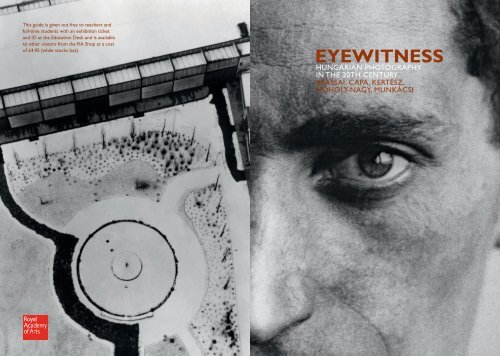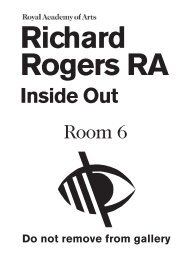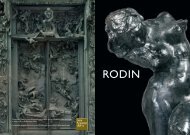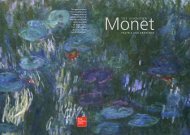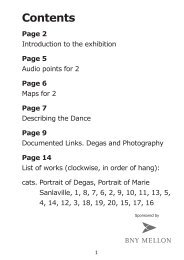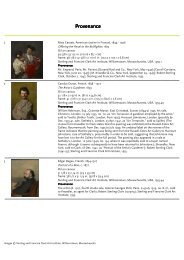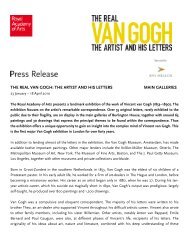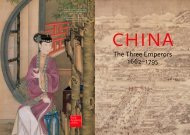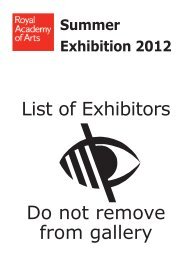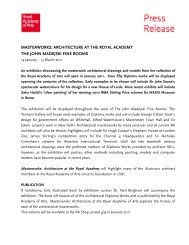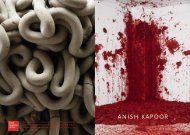EYEWITNESS - Royal Academy of Arts
EYEWITNESS - Royal Academy of Arts
EYEWITNESS - Royal Academy of Arts
Create successful ePaper yourself
Turn your PDF publications into a flip-book with our unique Google optimized e-Paper software.
This guide is given out free to teachers and<br />
full-time students with an exhibition ticket<br />
and ID at the Education Desk and is available<br />
to other visitors from the RA Shop at a cost<br />
<strong>of</strong> £4.95 (while stocks last).<br />
<strong>EYEWITNESS</strong><br />
HUNGARIAN PHOTOGRAPHY<br />
IN THE 20TH CENTURY<br />
BRASSAÏ, CAPA, KERTÉSZ,<br />
MOHOLY-NAGY, MUNKÁCSI<br />
iii
<strong>EYEWITNESS</strong><br />
HUNGARIAN PHOTOGRAPHY<br />
IN THE 20TH CENTURY<br />
BRASSAÏ, CAPA, KERTÉSZ,<br />
MOHOLY-NAGY, MUNKÁCSI<br />
The Sackler Wing <strong>of</strong> Galleries<br />
30 June – 2 October 2011<br />
An Introduction to the Exhibition<br />
for Teachers and Students<br />
Written by Owen Hopkins<br />
For the Education Department<br />
© <strong>Royal</strong> <strong>Academy</strong> <strong>of</strong> <strong>Arts</strong><br />
Exhibition organised by the <strong>Royal</strong> <strong>Academy</strong> <strong>of</strong> <strong>Arts</strong><br />
on the occasion <strong>of</strong> the Hungarian Presidency <strong>of</strong> the EU 2011<br />
Supported by<br />
Front Cover Cat. 42, KATA KÁLMÁN, Ernő Weisz, Factory Worker (detail)<br />
Back Cover Cat. 69, LÁSZLÓ MOHOLY-NAGY, Berlin Radio Tower (detail)<br />
Designed by Isambard Thomas, London. Printed by Tradewinds Ltd<br />
INTRODUCTION<br />
‘It’s not enough to have talent, you also have to be Hungarian.’ ROBERT CAPA<br />
This remark by Robert Capa (1913–1954), although perhaps partly made<br />
in jest, refers to the extraordinary prevalence <strong>of</strong> Hungarian photographers<br />
among the great names <strong>of</strong> twentieth-century photography. In 1938, while still<br />
only 25, Capa himself was described in London’s Picture Post as ‘The Greatest<br />
War-Photographer in the World’. Capa, along with his famous compatriots,<br />
Brassaï (1899 –1984), André Kertész (1894–1985), László Moholy-Nagy<br />
(1895–1946) and Martin Munkácsi (1896–1963), whose work together<br />
forms the largest part <strong>of</strong> this exhibition, are all universally recognised as<br />
being among the most innovative and influential photographers <strong>of</strong> the<br />
twentieth century.<br />
Although all born in Hungary, these five photographers mostly made their<br />
names outside their homeland. All were Jewish, but none strictly religious, and<br />
the fact that they changed their birth names – Gyula Halász (Brassaï), Endre<br />
Friedmann (Capa), Andor Kohn (Kertész), László Weisz (Moholy-Nagy), Márton<br />
Mermelstein (Munkácsi) – is indicative <strong>of</strong> the anti-Semitism they encountered<br />
at various points in their lives. In the decades following the First World War<br />
(1914–18), in which Brassaï, Kertész and Moholy-Nagy actually fought,<br />
worsening political and economic conditions led to the evaporation <strong>of</strong><br />
the rich cultural and artistic climate in Hungary. Budapest was no longer<br />
conducive to the ambitions <strong>of</strong> these young men.<br />
In 1914, Hungary entered the First World War as part <strong>of</strong> the Austro-<br />
Hungarian Empire and, four years later, found itself on the losing side. The<br />
Austro-Hungarian monarchy collapsed and Hungary became an independent<br />
country, but at the same time lost 72% <strong>of</strong> its territory in the subsequent<br />
redrawing <strong>of</strong> the map, and saw its population drastically reduced. After<br />
ashort-lived democratic government and an even briefer communist<br />
regime, Admiral Miklós Horthy seized power in 1919 and his conservative<br />
authoritarian government remained in control until 1944. Horthy’s<br />
oppressive regime launched a two-year campaign known as the ‘White Terror’:<br />
a strategy <strong>of</strong> persecution and violence against communists, liberals, artists<br />
and intellectuals (and therefore large numbers <strong>of</strong> Jewish people). Restrictions<br />
were also put on the number <strong>of</strong> Jewish applicants to university, severely<br />
limiting their future prospects in Hungary. All this acted to hasten emigration,<br />
with many leaving for Europe and beyond.<br />
Berlin, London, Vienna and Paris, hotbeds for the arts in the 1920s and ’30s,<br />
were popular destinations for the Hungarian émigrés. Moholy-Nagy arrived in<br />
Vienna soon after the war and about a year later went to Germany where he<br />
taught and experimented in photography at the famous Bauhaus art school.<br />
Munkácsi achieved success in Berlin as a photojournalist, but with the growing<br />
threat <strong>of</strong> fascism looming over Europe in the 1930s, he, Capa, Moholy-Nagy<br />
and Kertész all left for America at different times. Only Brassaï continued to<br />
live in Paris. Moholy-Nagy became director <strong>of</strong> the short-lived New Bauhaus<br />
1
2<br />
Cat.12<br />
ANDRÉ KERTÉSZ<br />
Children Admiring My Camera<br />
Budafok, 1919<br />
Silver gelatin print, 1967<br />
20.4 x 25.3 cm<br />
Hungarian Museum <strong>of</strong> Photography<br />
© Estate <strong>of</strong> André Kertész/Higher Pictures<br />
in Chicago, while Kertész and Munkácsi worked as commercial photographers<br />
in New York.<br />
The wide recognition these five photographers achieved was in many ways<br />
dependent on them having left their homeland. Yet their contribution to<br />
twentieth-century photography was to some extent shaped by the vibrant<br />
photographic tradition in Hungary before the Second World War, which the<br />
first part <strong>of</strong> this exhibition documents. Following the war, Hungary fell behind<br />
the Iron Curtain and was largely isolated from Western artistic developments.<br />
The final part <strong>of</strong> the exhibition examines those photographers working<br />
in Hungary from this time until the fall <strong>of</strong> the Berlin Wall in 1989. The<br />
achievements and innovations <strong>of</strong> those celebrated five were to have<br />
a lasting impact on different aspects <strong>of</strong> photography in the twentieth century<br />
in Hungary and beyond, defining the modern genres <strong>of</strong> photojournalism,<br />
documentary, fashion, and art photography.<br />
PHOTOGRAPHY IN HUNGARY<br />
1914–1939<br />
At the beginning <strong>of</strong> the twentieth century, photography was<br />
already well established in Hungary. Several amateur photography<br />
clubs were in existence, and the first years <strong>of</strong> the century saw the<br />
foundation <strong>of</strong> a number <strong>of</strong> photography journals, as well as the Magyar<br />
Fényképészek Országos Szövetsége (National Association <strong>of</strong> Hungarian<br />
Photographers), which sought to defend the pr<strong>of</strong>essional interests<br />
<strong>of</strong> photographers.<br />
At this time in Hungary, as elsewhere, most photographs were taken<br />
using plate cameras, which worked by recording the photographic<br />
image on a glass plate coated with an emulsion <strong>of</strong> light-sensitive silver<br />
salts. Plate cameras tended to be large and cumbersome and usually<br />
required the use <strong>of</strong> a tripod. As each plate had to be carefully removed<br />
and replaced with another before the next photograph could be<br />
taken, many early photographs were <strong>of</strong> staged or static scenes.<br />
Cat.12 Another consequence for the photographer <strong>of</strong> using a plate<br />
camera was that it made their activity conspicuous to those being<br />
photographed. In this early photograph by Kertész, we see five children<br />
fascinated by his camera in the rural village <strong>of</strong> Budafok. While the four<br />
boys are absorbed by the camera itself, and are actually looking<br />
through its viewfinder as it frames the surrounding area, the young girl<br />
looks directly at the viewer – and, therefore, at the photographer too.<br />
The spontaneous, snapshot quality which Kertész achieved here was<br />
to become particularly prevalent in subsequent years. Photographers<br />
like Kertész took to the streets armed with the Leica, a new small and<br />
lightweight camera that used 35-mm film. First released in 1925, the<br />
Leica’s impact was revolutionary as photographers began to immerse<br />
themselves in their surroundings, waiting for what the great French<br />
photographer Henri Cartier-Bresson famously termed the ‘decisive moment’.<br />
This, Cartier-Bresson wrote, was:<br />
‘[the] creative fraction <strong>of</strong> a second when you are taking a picture. Your eye must see<br />
a composition or an expression that life itself <strong>of</strong>fers you, and you must know with<br />
intuition when to click the camera. That is the moment the photographer is creative.’<br />
That Kertész and others were already striving for this quality before the<br />
Leica’s advent, as revealed in this photograph, was something that he<br />
himself noted: ‘I took photos with the Leica before the invention <strong>of</strong> the Leica.’<br />
Rural locations were a popular subject in Hungary in the years following<br />
the First World War. In 1914, the photographer Rudolf Balogh first published<br />
Fotómüvészet (Photo Art) in which he proclaimed that:<br />
‘There is no need to photograph the formulaic landscapes <strong>of</strong> international tastes. Let us stay<br />
here, searching for and finding subjects within our own country that will make us successful<br />
abroad; let us create a Hungarian photo art, with Hungarian air and a clear Hungarian sky!’<br />
‘We need photographs<br />
to communicate our<br />
particularities and our<br />
national character.’<br />
RUDOLF BALOGH, 1914
Cat.8<br />
RUDOLF BALOGH<br />
Stud<br />
Hortobágy, 1930<br />
Vintage silver gelatin print<br />
38 x 28.3 cm<br />
Hungarian Museum <strong>of</strong> Photography<br />
© Hungarian Museum <strong>of</strong> Photography<br />
‘These photographs should<br />
be the weapons <strong>of</strong> the<br />
class struggle.’<br />
LAJOS GRÓ, MUNKA-KÖR, 1932<br />
Cat.42<br />
KATA KÁLMÁN<br />
Ernő Weisz, Factory Worker<br />
Budapest, 1932<br />
Silver gelatin print, 1968<br />
24 x 18.3 cm<br />
Hungarian Museum <strong>of</strong> Photography<br />
© DACS 2011<br />
Cat.8 The pastoral scene <strong>of</strong> Balogh’s photograph Stud is typical <strong>of</strong> the bucolic<br />
visions <strong>of</strong> Hungarian landscapes and villages that became known as the ‘Magyar<br />
Style’ or ‘Hungarian Style’. As the title notes, the action takes place on a stud<br />
farm, with a figure on horseback rounding up several other horses or perhaps<br />
seeking a particular individual. The whiteness <strong>of</strong> the rider’s smock draws our<br />
eye towards him as the principal figure. Yet the action remains confined to<br />
a comparatively small part <strong>of</strong> the frame, with the huge expanse <strong>of</strong> sky<br />
dominating the scene below it. This dramatic composition was not arrived at<br />
by chance. Balogh combined two negatives – one <strong>of</strong><br />
the stud farm and one <strong>of</strong> the sky – masking and printing<br />
part <strong>of</strong> each to create a combination image, which<br />
heightens the overall sense <strong>of</strong> drama and emphasises<br />
the unique beauty <strong>of</strong> the great Hungarian plains.<br />
The nostalgic and romanticised approach <strong>of</strong> the<br />
‘Hungarian Style’ photographers was not the only mode<br />
<strong>of</strong> photographic practice in Hungary between the wars.<br />
Other photographers worked in ‘social-documentary’:<br />
<strong>of</strong>ten politically inspired, this mode <strong>of</strong> photography<br />
sought to record the realities <strong>of</strong> life without allowing<br />
asentimental approach to poverty.<br />
Cat. 42 One <strong>of</strong> the best and most well known <strong>of</strong> these<br />
photographers was Kata Kálmán. In her photograph<br />
Ernő Weisz, Factory Worker, the subject gazes piercingly<br />
back at the viewer, his face tightly cropped by the<br />
photographic frame. In comparison to the s<strong>of</strong>t focus<br />
<strong>of</strong> Balogh’s Stud, here the focus is sharp, while the high<br />
contrast further adds to the image’s raw, visceral quality.<br />
Although she gives the name <strong>of</strong> the subject in the title,<br />
the inclusion <strong>of</strong> ‘Factory Worker’ immediately situates<br />
the subject within a particular social group and the<br />
individual becomes the collective face <strong>of</strong> this sector<br />
<strong>of</strong> society. Such subjects became increasingly frequent, especially for those<br />
photographers associated with the ‘Work Circle’ (Munka-kör) formed by<br />
Lajos Kassák in Budapest in the 1930s. For those in this group, photography<br />
presented a means <strong>of</strong> documenting reality in all its harshness, as a way<br />
<strong>of</strong> bringing attention to social injustices.<br />
Do you think that a photographer should always include in a photograph’s<br />
caption or title the name <strong>of</strong> the person or people they have captured? Why?<br />
In what ways do you think photography can be used to advance a particular<br />
social or political agenda?<br />
The development <strong>of</strong> the Leica gave photographers new freedom in how they<br />
operated, facilitating new subject matter and photographic styles. Do you<br />
think that modern digital photography has had an equivalent effect?<br />
4 5
6<br />
MOVING AWAY<br />
‘Hungarians are the only people in Europe without racial or linguistic relatives in Europe,<br />
therefore they are the loneliest on this continent. This … perhaps explains the peculiar<br />
intensity <strong>of</strong> their existence … Hopeless solitude feeds their creativity, their desire for<br />
achieving … To be Hungarian is a collective neurosis.’<br />
ARTHUR KOESTLER, QUOTED IN KATI MARTON, THE GREAT ESCAPE: NINE JEWS WHO FLED HITLER AND<br />
CHANGED THE WORLD, 2006<br />
MOHOLY-NAGY<br />
Second only to Paris as an artistic capital in the 1920s and ’30s, Berlin<br />
attracted many Hungarians, with over 19,000 living in the city during this time.<br />
A large number worked in its thriving film and newspaper industries; Brassaï<br />
and Capa had in fact both come to Berlin as newspaper correspondents<br />
before departing for Paris, and Munkácsi was based there between 1928<br />
and 1934, However, it was Moholy-Nagy who made the greatest impact in<br />
Germany. There he produced arguably his best-known photographs while<br />
teaching at the Bauhaus between 1923 and 1928.<br />
The Bauhaus was founded in 1919 by the architect Walter Gropius<br />
(1883 –1969) and relocated to its famous premises in Dessau, designed by<br />
Gropius himself, in 1925. Strongly modernist in outlook, the Bauhaus philosophy<br />
sought to bring together all the arts and so dissolve the distinction between<br />
‘fine arts’ (such as easel painting or sculpture) and ‘applied arts’ (such as textiles<br />
or interior design). Teaching at the Bauhaus encompassed art, typography,<br />
graphic and even industrial design, as well as architecture, prioritising industry<br />
and mass production over individual craftsmanship. For Moholy-Nagy this was<br />
the ideal environment for experimentation in photography, a medium that<br />
was inherently mass producible and could be used for advertising purposes<br />
in magazines, but that also opened up new possibilities for art.<br />
Many <strong>of</strong> Moholy-Nagy’s photographic experiments involved composite<br />
images. These included photograms (photographs produced without a camera),<br />
photomontages and photographs with multiple exposures and solarisation<br />
(an effect created by exposing a print to light during the developing process).<br />
In many ways these processes reflected his interest in Constructivism, a trend<br />
in Russian art and architecture that had emerged following the 1917 Russian<br />
Revolution. Exemplified in the work <strong>of</strong> Alexander Rodchenko and Vladimir<br />
Tatlin, Constructivism’s highly abstract and fragmented forms in painting,<br />
sculpture and photography drew great inspiration (and sometimes<br />
appropriated materials) from the industrial world. Dissolving the boundaries<br />
between fine art and industrial design, Constructivism rejected the notion<br />
<strong>of</strong> autonomous art – that is ‘art for art’s sake’ – in favour <strong>of</strong> creating a new<br />
visual language aligned with social ideals.<br />
Cat.69 With its strong graphic force, Berlin Radio Tower illustrates well Moholy-<br />
Nagy’s interest in Constructivism, rendering this stark scene almost wholly<br />
abstract. The photograph is taken looking down from the Berlin radio tower,<br />
built between 1924 and 1926, at the buildings and surrounding snow-covered<br />
ground. Uncompromisingly modern, the tower’s function and appearance<br />
strongly echo the radio tower in Moscow, designed by Vladimir Shukhov a few<br />
years earlier. The Berlin radio tower was <strong>of</strong> particular interest to Moholy-Nagy<br />
and he took several photographs <strong>of</strong> and from it. The viewpoint looking down<br />
from above was frequently used in modernist photography to create abstract<br />
compositions without compromising photography’s apparently relentless<br />
realism. For Moholy-Nagy such images were indicative <strong>of</strong> what he called ‘the<br />
New Vision’: the conviction that photography could reveal a side <strong>of</strong> the world<br />
that was invisible to the naked eye, by presenting it in an unfamiliar image<br />
through the ‘objective’ lens <strong>of</strong> the camera. The fact that this photograph was<br />
taken from such an emblem <strong>of</strong> modernity as a radio tower adds further<br />
weight to the idea that photography was the medium for representing the<br />
modern age.<br />
Although Moholy-Nagy’s ‘New Vision’ could be seen as roughly equivalent<br />
to Constructivism conceptually and aesthetically, it differed markedly in its lack<br />
<strong>of</strong> ideological underpinning. Moholy-Nagy’s work was not directed towards<br />
a particular social or political agenda. Instead, he was principally concerned<br />
with the modernist exploration <strong>of</strong> the possibilities <strong>of</strong> photography as<br />
a medium, and was not averse to the commercial application <strong>of</strong> his<br />
photographic and design work.<br />
Moholy-Nagy resigned from the<br />
Bauhaus in 1928, and after spending<br />
time in Holland, Paris and London,<br />
he left for America in 1937. He<br />
served as director <strong>of</strong> the very<br />
short-lived New Bauhaus in<br />
Chicago before opening his own<br />
School <strong>of</strong> Design there in 1938.<br />
Shortly after the end <strong>of</strong> the Second<br />
World War, Moholy-Nagy died <strong>of</strong><br />
leukaemia. His artistic legacy and<br />
dedication to teaching live on at<br />
the University <strong>of</strong> Art and Design<br />
in Budapest, now named after him,<br />
and in his School <strong>of</strong> Design, now<br />
part <strong>of</strong> Illinois Institute <strong>of</strong><br />
Technology.<br />
In what ways does the unusual<br />
viewpoint from which Moholy-<br />
Nagy took this photograph affect<br />
our understanding <strong>of</strong> how<br />
photography renders the<br />
three-dimensional world as<br />
atwo-dimensional image?<br />
Cat.69<br />
LÁSZLÓ MOHOLY-NAGY<br />
Berlin Radio Tower<br />
1928<br />
Silver gelatin print, 1973,<br />
from original negative<br />
26 x 20.4 cm<br />
Hungarian Museum <strong>of</strong> Photography<br />
© Hattula Moholy-Nagy/DACS 2011
8<br />
Cat.91<br />
BRASSAÏ<br />
Bijou <strong>of</strong> Montparnasse<br />
Paris, 1932<br />
Silver gelatine print, 1973<br />
23.5 x 25.5 cm<br />
Victoria and Albert Museum<br />
© Brassaï Estate – RMN<br />
Photo supplied © Victoria and Albert<br />
Museum, London<br />
‘This ancient cocotte<br />
[fashionable prostitute],<br />
who has outlived her<br />
seventieth autumn, and<br />
looks as if she had stepped<br />
out <strong>of</strong> Baudelaire’s most<br />
nightmarish pages, rejoices<br />
in the name <strong>of</strong> “Bijou”<br />
[jewel], and is a familiar figure<br />
in the Montmartre cabarets.’<br />
PAUL MORAND, PARIS DE NUIT,<br />
1932<br />
9
10<br />
BRASSAÏ<br />
Brassaï spent four years in Berlin working as a journalist before leaving for<br />
Paris in 1924. Paris was to remain his home, and be the focus <strong>of</strong> his work,<br />
for the rest <strong>of</strong> his life. He recalled that, on arriving in Paris, ‘I was not yet<br />
aphotographer and gave no thought at all to photography about which I knew<br />
nothing and even despised, when in about 1926, I met André Kertész.’ It was<br />
Kertész who introduced him to photography.<br />
Paris and its artistic cultures fascinated and absorbed Brassaï. As described<br />
by his friend the writer Henry Miller, Brassaï was ‘a wanderer … who sets out<br />
on an exploration with no other aim but continual investigation’; he was ‘the<br />
eye <strong>of</strong> Paris’. In 1930 Brassaï began taking the photographs that would become<br />
his celebrated book, Paris de Nuit (Paris after Dark). This early photo-book<br />
came to define the Paris <strong>of</strong> this era.<br />
Paris de Nuit combined sixty <strong>of</strong> Brassaï’s photographs with text by novelist,<br />
poet and playwright Paul Morand (1888 –1976). Although Morand’s name was<br />
bigger on the cover, it was Brassaï’s photography that revealed the eerie world<br />
shrouded under the cover <strong>of</strong> darkness, yet simultaneously brought into focus<br />
under the glare <strong>of</strong> modern electric light. In his introduction to the book,<br />
Morand charted this contradictory world, narrating a nocturnal promenade<br />
through the streets and describing the strange and sometimes-menacing<br />
characters found there:<br />
‘Night is not the negative <strong>of</strong> the day; black surfaces and white are not merely transposed,<br />
as on a photographic plate, but another picture altogether emerges at nightfall. At that hour<br />
atwilight world comes into being, a world <strong>of</strong> shifting forms, <strong>of</strong> false perspectives, phantom<br />
planes. There is something eerie, even disconcerting, about the process … a furtive menace<br />
pervades the Paris night; its darkness teems with unseen presences, the restless souls <strong>of</strong> the<br />
Parisians escaping through sleep-bound lips.’<br />
Cat.91 Although this particular image <strong>of</strong> the Bijou <strong>of</strong> Montparnasse was not<br />
actually included in Paris de Nuit, another <strong>of</strong> the same subject (with the same<br />
title and obviously taken at the same time) was printed. In this version, the<br />
woman sits at the table staring back at the viewer. She is expensively attired<br />
with hat and fur-trimmed coat. Her hands are, it seems, arranged so as to show<br />
<strong>of</strong>f her jewellery and the string <strong>of</strong> pearls draped around her neck. The heavy<br />
makeup on her face does not conceal the toll <strong>of</strong> countless years <strong>of</strong> work.<br />
Interestingly, in the photograph <strong>of</strong> the same subject included in Paris de Nuit,<br />
‘Bijou’ looks away from the camera, across the room at some anonymous<br />
gentlemen whose partial reflections are shown in the mirrors behind her.<br />
Without her arresting gaze this is arguably the less striking image. Yet it fits<br />
much better into the sequence <strong>of</strong> images in the book, few <strong>of</strong> which show<br />
figures engaging with the camera. The photographs selected for the book are<br />
carefully composed so as to portray the view <strong>of</strong> an outsider looking in,<br />
revealing with an unflinching gaze how familiar surroundings have become<br />
strange, an exotic underworld for potentially illicit activities. In Brassaï’s hands,<br />
the camera was the perfect instrument for revealing and capturing this hidden<br />
and ephemeral world.<br />
In Paris de Nuit Brassaï adopts the role <strong>of</strong> an observer; few, if any, <strong>of</strong> the<br />
subjects engage with the camera, and many <strong>of</strong> the photographs are taken<br />
from viewpoints looking across deserted streets and squares. Do you think<br />
it is possible for a photographer to act entirely as an observer? Or do they<br />
inescapably participate in and influence their subject?<br />
KERTÉSZ<br />
‘Kertész had two qualities which were essential to a great photographer: an insatiable<br />
curiosity <strong>of</strong> the world <strong>of</strong> life and <strong>of</strong> people, and a precise sense <strong>of</strong> form … But rarely are<br />
the two qualities found in the same person.’<br />
BRASSAÏ, ‘MY FRIEND ANDRÉ KERTÉSZ’, CAMERA, APRIL 1963<br />
Kertész had little formal training in photography. Before the First World War,<br />
he took his first amateur photographs <strong>of</strong> rural village scenes and everyday<br />
moments in the city <strong>of</strong> Budapest where he lived. Called up to the army in<br />
1914, he took photographs (many now destroyed) <strong>of</strong> life in the trenches,<br />
before being seriously wounded in 1915. After the war, while working variously<br />
as a clerk and in agriculture, he frequently sent his work to photographic<br />
magazines. He left for Paris in 1925 and quickly found both critical and<br />
commercial success. Through fellow émigrés who had settled in Paris, Kertész<br />
was introduced and became close to the Paris artistic community, Hungarians<br />
and non-Hungarians alike, and took pictures <strong>of</strong> many artistic luminaries,<br />
among them Mondrian and Chagall.<br />
Cat.105 Kertész’s photography is characterised by an overriding interest in<br />
and tenderness towards people going about their daily lives. One <strong>of</strong> his most<br />
evocative images is Elizabeth and I, taken in 1931, depicting him and his wife,<br />
Elizabeth. In this photograph, we see half <strong>of</strong> Elizabeth’s face as she looks back<br />
at the camera. His hand clasps her right shoulder. The hand is a caring,<br />
protective one, there to <strong>of</strong>fer reassurance rather than control. Interestingly,<br />
this photograph is a result <strong>of</strong> a deliberate decision (made three decades after<br />
the photograph was taken) to tightly crop the original negative, which showed<br />
more <strong>of</strong> the figures and the room in which they sit. However, in this version, by<br />
11
12<br />
Cat.105<br />
ANDRÉ KERTÉSZ<br />
Elizabeth and I<br />
Paris, 1931<br />
Silver gelatin print, 1967<br />
25.2 x 20.2 cm<br />
Hungarian Museum <strong>of</strong> Photography<br />
© Estate <strong>of</strong> André Kertész/Higher Pictures<br />
removing any specificity from the photograph through tight cropping, the<br />
dynamic <strong>of</strong> a whole relationship is seemingly distilled into a single image.<br />
Ahighly personal photograph becomes one with universal resonance.<br />
With the spectre <strong>of</strong> Nazism looming over Europe during the 1930s, and<br />
finding it increasingly hard to secure commissions, Kertész and Elizabeth left<br />
Paris for New York in 1936. Kertész found life in America difficult. He had<br />
struggled with the French language while in Paris and his subsequent difficulties<br />
with English left him something <strong>of</strong> an outsider. Despite finding work for<br />
avariety <strong>of</strong> magazines he frequently found his creative freedom restricted<br />
by their editors. To compound matters, in 1941 Kertész and Elizabeth were<br />
designated as enemy aliens on account <strong>of</strong> Hungary entering the war against<br />
the Allies. For a time, his pr<strong>of</strong>essional activities were curtailed, and he could<br />
not easily obtain photographic supplies.<br />
Cat.128 Many <strong>of</strong> his photographs from this period,<br />
though frequently as imaginative and adventurous as<br />
his Paris work, are <strong>of</strong>ten tinged with melancholy and<br />
nostalgia. On one such work, Lost Cloud, taken shortly<br />
after he arrived in New York, Kertész commented: ‘What<br />
I felt when making this photo was a feeling <strong>of</strong> solitude –<br />
the cloud didn’t know which way to go.’ The photograph<br />
speaks <strong>of</strong> the isolation Kertész felt in this unfamiliar city:<br />
the solitary cloud stands in stark contrast, both formally<br />
and tonally, to the colossal and characteristically New<br />
York building which ascends to the top <strong>of</strong> the frame<br />
<strong>of</strong> the photograph (and beyond).<br />
By 1946 Kertész was beginning to feel more accepted<br />
in America. The cosmetics company Elizabeth had started<br />
was doing well and Kertész was revelling in the success<br />
<strong>of</strong> an exhibition <strong>of</strong> his work at the Art Institute <strong>of</strong><br />
Chicago. He continued his commercial work, having<br />
signed a long-term exclusive contract with House and<br />
Garden magazine. While this provided financial security,<br />
he felt increasingly stifled and broke <strong>of</strong>f the contract in<br />
1961. By this time he was beginning to receive the kind<br />
<strong>of</strong> international recognition he felt his work had long<br />
deserved, and in 1964 John Szarkowski, the newly<br />
appointed Director <strong>of</strong> Photography at MoMA, staged<br />
a solo show <strong>of</strong> Kertész’s work, confirming him as one<br />
<strong>of</strong> the greats <strong>of</strong> twentieth-century photography.<br />
‘The message a photograph conveys is entirely dependent on the content<br />
<strong>of</strong> the image.’ Do you agree with this statement? Do you think it is possible<br />
to discern anything about a photographer’s mental state from their<br />
photographs?<br />
Cat.128<br />
ANDRÉ KERTÉSZ<br />
Lost Cloud<br />
New York, 2 March, 1937<br />
Silver gelatin print, 1970s<br />
25 x 20.3 cm<br />
Estate <strong>of</strong> André Kertész. Courtesy Vintage<br />
Gallery, Budapest<br />
© Estate <strong>of</strong> André Kertész/Higher Pictures<br />
Photo Courtesy Vintage Gallery, Budapest<br />
13
14<br />
Cat.107<br />
MARTIN MUNKÁCSI<br />
Four Boys at Lake Tanganyika<br />
c.1930<br />
Silver gelatin print, 1994,<br />
from original negative<br />
35.5 x 27.5 cm<br />
Hungarian Museum <strong>of</strong> Photography<br />
© Estate <strong>of</strong> Martin Munkácsi, courtesy<br />
Howard Greenberg Gallery, New York<br />
MUNKÁCSI<br />
Munkácsi was perhaps the most accomplished photojournalist <strong>of</strong> the<br />
photographers who emerged from Hungary in the 1920s and ’30s. He<br />
began as a journalist at the age <strong>of</strong> eighteen, taking photographs to illustrate<br />
his articles. For Munkácsi photojournalism was about:<br />
‘[seeing to] within a thousandth <strong>of</strong> a second the things that indifferent people blindly pass by<br />
–this is the theory <strong>of</strong> photo reportage. And the things we see within this thousandth <strong>of</strong> a<br />
second, we should then photograph during the next thousandth <strong>of</strong> a second – this is the<br />
practical side <strong>of</strong> photo reportage.’<br />
Initially, Munkácsi specialised in sports photography but he soon branched out<br />
into other areas. Working for several publications, he always looked for unusual<br />
angles and the results were so successful that he was soon able to boast that<br />
he was the highest-paid photographer in Hungary. The fame he garnered from<br />
this helped him secure a job in Berlin working for Berliner Illustrirte Zeitung<br />
(BIZ) which had the highest circulation in Germany <strong>of</strong> any illustrated weekly<br />
paper.<br />
Cat.107 While working for BIZ Munkácsi travelled all over the world with his<br />
camera. In 1930, he took one <strong>of</strong> his most celebrated photographs: Four Boys<br />
at Lake Tanganyika (although despite its traditional title, this photograph was<br />
probably taken on Liberia’s Atlantic coast). The high shutter speed, which<br />
captured the movement in sharp detail, renders an image <strong>of</strong> timeless energy<br />
and dynamism. The lack <strong>of</strong> any signifiers tying it to a particular time (the boys<br />
are naked) further heightens its raw and elemental charm. Its influence on<br />
subsequent photography was pr<strong>of</strong>ound. Cartier-Bresson recalled:<br />
‘In 1932 I saw a photograph by Martin Munkácsi <strong>of</strong> three black children running into the sea,<br />
and I must say that it is that very photograph which was for me the spark that set fire to the<br />
fireworks … and made me suddenly realise that photography could reach eternity through<br />
the moment.’<br />
Back in Germany, Munkácsi recorded the rise <strong>of</strong> Nazism, most notably the<br />
fateful ‘Day <strong>of</strong> Potsdam’ in 1933, which saw Adolf Hitler assume power in<br />
Germany. Within months <strong>of</strong> this event, BIZ’s Jewish editor was removed from<br />
his post and Munkácsi himself left for America.<br />
Such was his fame, Munkácsi was immediately hired by Carmel Snow, editor<br />
<strong>of</strong> Harper’s Bazaar. Munkácsi, Snow recalled, ‘had never taken a fashion picture<br />
in his life’, but she commissioned him nonetheless. At the time most fashion<br />
photographs were meticulously staged studio-based tableaux. Munkácsi had<br />
other ideas, which drew on his experience in sports photography. For his first<br />
shoot, Snow took Munkácsi to Piping Rock Beach, where, she recounted, he<br />
‘made photographic history’:<br />
‘It seemed that what Munkácsi wanted was for the model to run toward him. Such a ‘pose’ had<br />
never been attempted before for fashion … The resulting picture <strong>of</strong> a typical American girl in<br />
action with her cape billowing out behind her, made photographic history … Munkácsi’s was<br />
the first action photograph made for fashion, and it started the trend that is climaxed in the<br />
work <strong>of</strong> [Richard] Avedon.’<br />
CARMEL SNOW, QUOTED IN PENELOPE ROWLANDS, A DASH OF DARING: CARMEL SNOW AND HER LIFE IN<br />
FASHION, ART, AND LETTERS, 2005<br />
15
16<br />
Cat.119<br />
MARTIN MUNKÁCSI<br />
The First Fashion Photo<br />
for Harper's Bazaar<br />
(Lucile Brokaw)<br />
America, 1933<br />
Silver gelatin print, 1994,<br />
from original negative<br />
35.5 x 27.5 cm<br />
Hungarian Museum <strong>of</strong> Photography<br />
© Estate <strong>of</strong> Martin Munkácsi, courtesy<br />
Howard Greenberg Gallery, New York<br />
Cat.119 In the photograph we can clearly see what had excited Snow so<br />
much. The blurriness <strong>of</strong> the image introduces a real sense <strong>of</strong> movement and<br />
dynamism; it appears natural, completely unlike the highly formal fashion<br />
photography Munkácsi rejected. Clearly borrowing from his sports journalism<br />
work and using his experience <strong>of</strong> capturing the essence <strong>of</strong> movement,<br />
Munkácsi turned fashion photography into photojournalism. This was not using<br />
photography to present clothes as things to be acquired; instead, this was an<br />
image <strong>of</strong> the life you could achieve if you owned and wore those garments.<br />
Munkácsi had transformed fashion photography overnight. As the famous<br />
fashion photographer Richard Avedon (1923–2004) observed, Munkácsi<br />
‘brought a taste for happiness and honesty and love <strong>of</strong> women to what was,<br />
before him, a joyless, lying art. He was the first … and today the world <strong>of</strong><br />
what is called fashion is peopled with Munkácsi’s babies, his heirs.’ For a time<br />
Munkácsi boasted about being New York’s highest paid photojournalist, but his<br />
position was soon displaced by others who had subsumed and extended his<br />
advances in the genre, and after suffering ill health he died relatively unknown.<br />
Unlike Munkácsi’s 1933 photograph for Harper’s Bazaar, many fashion<br />
photographs are manipulated, originally using darkroom effects and these<br />
days digitally. What do you think about these processes and the perception<br />
<strong>of</strong> photography as an apparently truthful medium? Do you think an altered<br />
image should be labelled as such?<br />
CAPA<br />
Born a year before the outbreak <strong>of</strong> the First World War, Capa was the<br />
youngest and the most politically engaged <strong>of</strong> the five photographers. War<br />
and the struggle against fascism defined his life and his photography. Capa<br />
documented the Spanish Civil War, the Second Sino-Japanese War, the Second<br />
World War all over Europe, the Arab-Israeli War <strong>of</strong> 1948 and the First Indo-<br />
China War. Regularly telling his friends, ‘I’m not a photographer, I’m a journalist,’<br />
Capa was far less interested in the exploration <strong>of</strong> photography as a medium,<br />
than in its ability to record and transmit the horror and tragedy <strong>of</strong> war. He<br />
frequently worked embedded within military units, and was not averse to<br />
putting himself in the line <strong>of</strong> fire to get the perfect shot – a practice that<br />
continues to define war photography today.<br />
Capa left Hungary at the age <strong>of</strong> eighteen for Vienna and then Berlin<br />
where, like many other Hungarians, he found work as a journalist. Working<br />
as a darkroom assistant, he soon began taking photographs himself. His first<br />
big commission came in 1932 when he was sent to photograph the Russian<br />
revolutionary Leon Trotsky speaking in Copenhagen, Denmark. Unlike<br />
the other photographers with their cumbersome press cameras, Capa<br />
photographed in 35-mm film, which uniquely captured Trotsky’s remarkable<br />
energy and inspiration.<br />
A Berlin newspaper gave over a whole page to his photographs <strong>of</strong> Trotsky<br />
delivering his speech, winning Capa considerable attention. Capa soon left<br />
Berlin for Paris, where Kertész helped him with contacts and some early jobs,<br />
as he had done for Brassaï a few years earlier. In Paris, he deliberately adopted<br />
the American-sounding name Robert Capa to make himself more attractive<br />
to editors. Cápa, meaning ‘shark’ in Hungarian, was his nickname in school;<br />
he purportedly chose this as a pr<strong>of</strong>essional name because <strong>of</strong> its similarity<br />
to that <strong>of</strong> American film director, Frank Capra (1897–1991). The plan worked,<br />
and he was soon commanding some <strong>of</strong> the highest fees around.<br />
In 1936, Lucien Vogel, the editor <strong>of</strong> Vu, a short-lived but innovative picture<br />
magazine modelled after those popular in Berlin, commissioned Capa to<br />
cover the Spanish Civil War which had just broken out. Capa remained in Spain<br />
until 1939, travelling with and photographing the Workers’ Party <strong>of</strong> Marxist<br />
Unification (POUM), with whom the journalist and author George Orwell<br />
(1903 –1950) served and was wounded. The civil war had started when a<br />
group <strong>of</strong> generals led by Francisco Franco (1892–1975) staged a coup d’état<br />
against the Republican government. Only partially successful, the coup led to<br />
aprotracted civil war in which an alliance <strong>of</strong> conservatives, monarchists and<br />
‘If your picture isn’t<br />
good enough, you’re<br />
not close enough.’<br />
ROBERT CAPA<br />
17
18<br />
Cat.108<br />
ROBERT CAPA<br />
Death <strong>of</strong> a Loyalist Militiaman<br />
Cerro Muriano, Cordoba<br />
1936<br />
Silver gelatin print, 1970,<br />
from original negative<br />
28 x 36 cm<br />
Hungarian Museum <strong>of</strong> Photography<br />
© ICP/Magnum Photos<br />
‘There seemed to be a loud<br />
bang and a blinding flash <strong>of</strong><br />
light all around me, and I felt<br />
a tremendous shock – no<br />
pain, only a violent shock,<br />
such as you get from an<br />
electric terminal; with it a<br />
sense <strong>of</strong> utter weakness, a<br />
feeling <strong>of</strong> being stricken and<br />
shrivelled up to nothing. …<br />
All this happened in a space<br />
<strong>of</strong> time much less than a<br />
second.’<br />
GEORGE ORWELL, ON BEING<br />
SHOT IN THE NECK, HOMAGE TO<br />
CATALONIA, 1938<br />
19
20<br />
‘The war correspondent has<br />
his stake – his life – in his<br />
own hands, and he can put it<br />
on this horse or that horse,<br />
or he can put it back in his<br />
pocket at the very last<br />
minute. I am a gambler.<br />
Idecided to go in with<br />
Company E in the first wave.’<br />
ROBERT CAPA RECALLING THE<br />
EVENTS OF D-DAY IN HIS<br />
MEMOIR SLIGHTLY OUT OF FOCUS,<br />
1947<br />
fascists – self-styled as ‘Nationalists’ – were opposed by an <strong>of</strong>ten uneasy<br />
agglomeration <strong>of</strong> liberals, socialists, communists and anarchists, including<br />
the POUM, fighting for the Republican cause.<br />
Often regarded as the first ‘media war’, the Spanish Civil War was covered<br />
by numerous journalists and correspondents, including some, like Orwell, who<br />
actually engaged in the fighting. The reports and photographs coming back to<br />
Britain and France from correspondents in Spain galvanised public sentiment<br />
and led to many foreign volunteers leaving for Spain to join the Republican<br />
cause.<br />
Cat. 108 The most famous photograph <strong>of</strong> the conflict is undoubtedly Capa’s<br />
Death <strong>of</strong> a Loyalist Militiaman. The photograph records the moment a POUM<br />
soldier falls to his death after being shot by an enemy bullet. It is a strikingly<br />
iconic image, in part because <strong>of</strong> its composition. The soldier’s tragic pose<br />
uncannily recalls those from religious history paintings. Yet, the image’s power<br />
derives from the innate characteristics <strong>of</strong> photography. The unbalanced pose<br />
with the figure falling away from the camera, his gun slipping from his hand, his<br />
head caught turning away from the camera as he falls, all serve to create a<br />
tangible sense <strong>of</strong> pathos as this tragic moment is caught in an instant by the<br />
camera. Channelled through the graininess and immediacy <strong>of</strong> the photographic<br />
image, the figure stands as an extraordinary index <strong>of</strong> the whole conflict, and<br />
indeed <strong>of</strong> war itself.<br />
Capa returned to Paris when the war came to a close, his reputation as one<br />
<strong>of</strong> the world’s greatest war photographers assured. At the outbreak <strong>of</strong> the<br />
Second World War (1939) he left for New York, but despite his ‘enemy alien’<br />
status (the same as Kertész) he was, with the help <strong>of</strong> influential friends, able to<br />
accompany and photograph several Allied military units during the European<br />
campaign. His most iconic photographs <strong>of</strong> the Second World War, perhaps the<br />
most famous by any photographer, recorded the D-Day landings by American<br />
troops on Omaha beach in Normandy, France.<br />
By 1944, the Allies had been planning the invasion <strong>of</strong> mainland Europe for<br />
nearly two years, and in anticipation <strong>of</strong> the invasion, Capa flew to Britain to<br />
wait for events to unfold. On 6 June 1944 the invasion finally began. In a<br />
meticulously prepared operation, over 150,000 Allied troops crossed the<br />
Channel for Normandy while the Nazi troops waited along the heavily fortified<br />
beachfronts. Just after 4 am, Capa leapt ashore from a landing craft among<br />
American troops. A hail <strong>of</strong> bullets rained down from the German fortifications<br />
above. Capa himself was armed with two cameras and in the ensuing chaos<br />
over the next hour was able to take over 100 photographs, before jumping<br />
aboard a boat removing wounded soldiers from the beach.<br />
Cat. 137 Before the advent <strong>of</strong> television, photographs were the first images<br />
audiences back home would have seen <strong>of</strong> the invasion. As soon as he arrived<br />
back in Britain, Capa had the films sent to the London <strong>of</strong>fice <strong>of</strong> Life magazine<br />
to be developed, hoping to make the magazine’s next issue in New York.<br />
Unfortunately, in the haste to get the photographs developed, the negatives<br />
were placed in a drying cabinet with the temperature set too high. Just eleven<br />
photographs survived, and even these were quite blurred. Nevertheless, Capa’s<br />
photographs present a remarkable record <strong>of</strong> this scarcely imaginable scene, and<br />
their emotional impact is for many only heightened by their blurred and grainy<br />
appearance, which testifies to the extreme conditions in which they were<br />
made.<br />
Capa died in 1954 after stepping on a landmine while photographing the<br />
First Indo-China War in Vietnam. The next year American forces became<br />
engaged in the conflict, and the ensuing, deeply controversial Vietnam War<br />
lasted for the best part <strong>of</strong> twenty years. The American public’s perception<br />
<strong>of</strong> the conflict was greatly influenced by the work <strong>of</strong> numerous war<br />
photographers, who <strong>of</strong>ten risked their lives to capture images that brought<br />
home the sheer brutality <strong>of</strong> war. Capa’s pioneering example paved the way for<br />
many <strong>of</strong> these and other war photographers, and his legacy continues to be a<br />
great source <strong>of</strong> inspiration for photographers today.<br />
In 1955 Life magazine and the Overseas Press Club <strong>of</strong> America established<br />
the Robert Capa Gold Medal Award to honour ‘the best photograph taken<br />
overseas with a courageous and adventurous spirit’. What responsibilities<br />
does a photographer have to the documentation <strong>of</strong> human conflicts?<br />
What characteristics <strong>of</strong> photography do you think allow it to be such<br />
a powerful medium, both politically and emotionally?<br />
Cat. 137<br />
ROBERT CAPA<br />
American Soldier Landing on<br />
Omaha Beach, D-Day<br />
Normandy, 6 June 1944<br />
Silver gelatin print, 1970, from<br />
original negative<br />
28 x 36 cm<br />
Hungarian Museum <strong>of</strong> Photography<br />
© ICP/Magnum Photos<br />
21
22<br />
PHOTOGRAPHY IN HUNGARY 1945–1989<br />
After trying unsuccessfully to pull out <strong>of</strong> the Second World War, Miklós<br />
Horthy’s regime ended in 1944 when Hungary was invaded by Germany, its<br />
previous ally. In the final months the bridges <strong>of</strong> Budapest were destroyed and<br />
many Jewish people deported to concentration camps. In the aftermath <strong>of</strong> the<br />
war, under the influence <strong>of</strong> the Soviet Union, a communist government took<br />
charge in 1949 and like so many eastern European states, Hungary fell behind<br />
the Iron Curtain separating East from West.<br />
The communist authorities worked hard to ensure there was little, if any,<br />
cultural exchange with the capitalist West. Photography, a medium uniquely<br />
appropriate for the dissemination <strong>of</strong> propaganda, was co-opted into the<br />
service <strong>of</strong> furthering the communist cause. By the 1950s, avant-garde artistic<br />
practices and modernist approaches that had previously been connected with<br />
the communist revolution in Russia were outlawed, following the edict <strong>of</strong> the<br />
Soviet leader Joseph Stalin. Socialist Realism was strictly enforced as the <strong>of</strong>ficial<br />
artistic style, and was taken up as such by the authorities in the years to follow.<br />
Socialist Realism prescribed images <strong>of</strong> common workers going about their<br />
everyday activities, as heroes <strong>of</strong> the communist cause. Interestingly, though its<br />
ideological content differed decidedly, in appearance Socialist Realism had<br />
much in common with the pre-war Hungarian Style in its idealisation <strong>of</strong> rural<br />
labour. During the early Soviet period when Socialist Realism was at its zenith<br />
in Hungary, Kata Kálmán was involved in organising a series <strong>of</strong> monographs on<br />
some <strong>of</strong> the stars <strong>of</strong> the Hungarian Style. She herself revisited its subject<br />
matter in her own photography but in a mode now infused with irony, an<br />
implicit critique <strong>of</strong> the oppressive regime.<br />
The fact that no Hungarian photographs were published <strong>of</strong> the actual<br />
events <strong>of</strong> the Hungarian Revolution <strong>of</strong> 1956, when a popular uprising was<br />
brutally suppressed by Soviet military forces, is indicative <strong>of</strong> the hold the<br />
communist authorities had over photography. While on the margins some<br />
interesting work was produced, especially in the realms <strong>of</strong> social documentary,<br />
isolated from the rapid and significant developments happening in the West,<br />
the quality <strong>of</strong> Hungarian photography lost the vigour it had had earlier in<br />
the century. The political climate was less conducive to artistic expression;<br />
photographers who had previously run independent studios were now<br />
regulated by the state. Yet, although they lacked the outlet <strong>of</strong> galleries and<br />
publications, they continued to experiment. In the 1960s and ’70s there was<br />
agrowing interest in conceptual photography, coupled with a continuation<br />
<strong>of</strong> the tradition <strong>of</strong> social documentary projects. With the loosening <strong>of</strong><br />
restrictions on the flow <strong>of</strong> information into Hungary during the 1980s,<br />
together with improvements in higher education opportunities, Hungarian<br />
photography gradually regained momentum, and some recognition abroad.<br />
Cat. 180 In 1989 Hungary’s borders were once again opened up to the West.<br />
Imre Benkő’s photograph <strong>of</strong> Russian Soldiers Leaving records the withdrawal <strong>of</strong><br />
Cat. 180<br />
IMRE BENKŐ<br />
Russian Soldiers Leaving<br />
Hajmáskér, 1990<br />
Vintage silver gelatin print<br />
23.8 x 16.4 cm<br />
Hungarian National Museum, Budapest<br />
© DACS 2011<br />
23
24<br />
Soviet troops. In a curiously timeless image, the downcast soldier gazes wistfully<br />
out <strong>of</strong> the window as he strums quietly on his guitar. Yet, despite the rather<br />
sombre downplaying <strong>of</strong> the occasion, the very fact that Benkő was able to take<br />
the photograph at all is a vivid illustration <strong>of</strong> the new freedom from Soviet<br />
control, for photography and society more broadly.<br />
With the opening up <strong>of</strong> its borders to the West, Hungarian photography<br />
was no longer isolated from the international mainstream. Subsuming Western<br />
photographic developments, Hungarian photography lost much <strong>of</strong> the<br />
distinctiveness it possessed earlier in the twentieth century. Yet the Hungarian<br />
contribution to shaping and redefining twentieth-century photography,<br />
especially through the examples <strong>of</strong> Brassaï, Capa, Kertész, Moholy-Nagy<br />
and Munkácsi, endures and continues to be felt to the present day.<br />
BIBLIOGRAPHY<br />
Péter Baki, Colin Ford and Georges Szirtes, Eyewitness, Hungarian Photography<br />
in the Twentieth Century: Brassaï, Capa, Kertész, Moholy-Nagy, Munkácsi,<br />
exh. cat., London, 2011<br />
Brassaï and Paul Morand, Paris After Dark, London, 1987<br />
(trans. <strong>of</strong> Paris de Nuit, Paris and London, 1932)<br />
Pierre Borhan (ed.), André Kertész: His Life and Work, Boston, 1994<br />
Cornell Capa and Richard Whelan (eds.), Robert Capa: Photographs,<br />
London, 1985<br />
Eleanor M. Hight, Picturing Modernism: Moholy-Nagy and Photography in<br />
Weimar Germany, Cambridge, Mass, 1995<br />
Susan Morgan, Martin Munkácsi: An Aperture Monograph, New York, 1992<br />
Cat.8 detail<br />
RUDOLF BALOGH<br />
Stud, 1930


